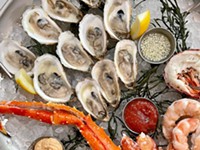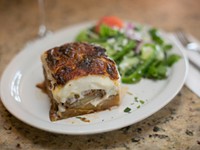[
{
"name": "500x250 Ad",
"insertPoint": "5",
"component": "15667920",
"parentWrapperClass": "",
"requiredCountToDisplay": "1"
}
]
I'm always grateful to restaurants that give me something to nibble on while I'm mulling over the menu. Sodam Korean in Henrietta, like all Korean restaurants, offers you a full meal while you think about what to order for dinner -- an assortment of small dishes known as banchan. These tasty offerings, which walk the line between condiment and snack food depending on your inclination and degree of restraint, are like a box of culinary crayons. Even before your meal comes, the table is covered with dishes full of primary colors and flavors lovingly prepared by chef and owner KwangchulKo: vibrant red, fiery kimchi; deep green, briny seaweed salad; icy white, crunchy bean sprouts; half moons of pickled cucumber dressed with garlic and chili paste; a generous square of sliced tofu, finished with soy, chili, and scallion. Each of these dishes presents elemental flavors and textures - sweet, sour, salty, spicy, silky smooth, and toothsomely crunchy. In combination, remarkable things happen.
Of course, in order to tinker with the flavors and textures of your food, you first have to find the restaurant - and that can be something of a trick. Like a speakeasy, Sodam is almost hidden at the far end of a converted warehouse in the Genesee Regional Market. Even the sign above the entrance is little help: it still reads "Korean House," the name that passed with the restaurant when the current owners purchased it five years ago. The only place you'll find the name Sodam - which means "cheerful" or "delicious" in Korean - is on a sign behind the restaurant's tinted front door.
In stark contrast to the cinderblock, industrial exterior, Sodam's dining room is warmly lit and comfortably furnished, hushed even when the restaurant is full to bursting with people lining up for tables at the door. Within minutes, your waitress will bring you your first round of banchan (you can ask for seconds of your favorites, so don't feel shy about digging in), and your meal is off to a pleasant start.
An order of shumai($3.95) is a nice supplement to your banchan, and a good illustration of the sort of games that you can play with your food at Sodam. Alone, these are very tasty dumplings, deep-fried rather than steamed, filled with ground shrimp and a bit of crab roe -- the essence of saltiness in a crunchy shell. Pick up a bit of kimchi and add a blast of fire and a bit of sourness that brings the briny taste of the shrimp surging forward. Take up some seaweed and all you'll notice is the texture of the shrimp and the crunch of the wonton skin.
For those looking for a more substantial appetizer, the pah-jeon - a crispy pancake made of rice flour into which scallions and other vegetables have been mixed - is a good bet ($5.95; with kimchi, $6.95; with seafood, $9.95). Crunchy outside, creamy within, and served still sizzling from the pan, it tastes fresh, its crunch entirely satisfying, and its flavors neutral enough that with the appropriate combination of banchan you can make it anything you want. I'm partial to alternating a dip in the accompanying teriyaki sauce with bits of kimchi and cooling bites of cucumber.
Noodles and soup make up the backbone of Korean cuisine, and both chef Ko's soups and stews are built on a delicious homemade white stock that simmers all day long, waiting to be doled out one or two ladles-full at a time. Into this stock he slides fat handmade rice noodles, slices of beef, beaten egg, and strips of nori to make kargooksu ($8.95). The same soup with delectably chewy discs of rice-stick and dumplings stuffed with beef becomes duk-mandu-gook ($9.95).
But the best use of this stock is when Ko pours it over a bowl full of braised beef shortribs and thick glass noodles and then enriches it with a roasted red-pepper powder akin to smoked paprika or chipotle powder - incandescent red with a bit of heat, but not nearly as much as you would expect. This kalbi-tang ($10.95) is served with a set of kitchen shears on the side. Diners jab the scissors into the broth and snip the fork-tender beef from the bones, spreading bits beefy goodness through the spicy soup, and making the mammoth shortribs into something that can be tackled with a spoon and a pair of chopsticks.
As red as this soup is, it is presents a practically blank canvas. The broth is flavorful with a good balance of sweetness and a nice round mouthfeel, and the ingredients are all perfectly cooked. But it all needs something - and fortunately there are ingredients to help you perfect your meal in easy reach. Grab some kimchi for extra heat, some cucumber for extra crunch and garlic, and then toss in the bean sprouts and a bit more seaweed and a good soup becomes a thing of beauty - something that can only be described as soul-satisfying and healing.
While the soup will heal you, Ko's pork bulgogi ($9.95) may well make you believe in a deity again. Those familiar with Korean food know about bulgogi, traditional Korean barbecue in which meat and veggies are cooked on a cast-iron platter and brought to the table preceded by the hissing sound of a hundred angry snakes and trailing clouds of billowing steam. Chef Ko's pork bulgogi is stunning: spicy enough to make even the most dedicated chili-head happy, but so flavorful that those with tamer tastes will brave the burn just to taste its peanutty goodness a second time. Peanuts, pork, and spice are natural allies, but there are no nuts at all in the dish. Chef Ko thickens his sauce with a toasted rice flour that lends a sweet nuttiness to the final product. Keep the cucumber and sprouts handy: you'll need them to cut the burn. And the mouth-confusing contrast between burning hot and ice cold will keep you enthralled long after you are too full to do anything but pick at the remains.
Speaking of...
-

Celebrate New Year's Eve without the stress at these 10 restaurants
Dec 27, 2022 -

Snack attacks at House of Whacks
Jun 1, 2021 -

Cuomo loosens capacity restrictions on restaurants
Mar 8, 2021 - More »
Latest in Dining Reviews
More by James Leach
-

DINING REVIEW: Orange Glory Cafe
May 15, 2013 -

Dish 2013: Updating the kiddie menu
May 8, 2013 -

DINING REVIEW: Opa Authentic Greek Koozina
May 1, 2013 - More »

